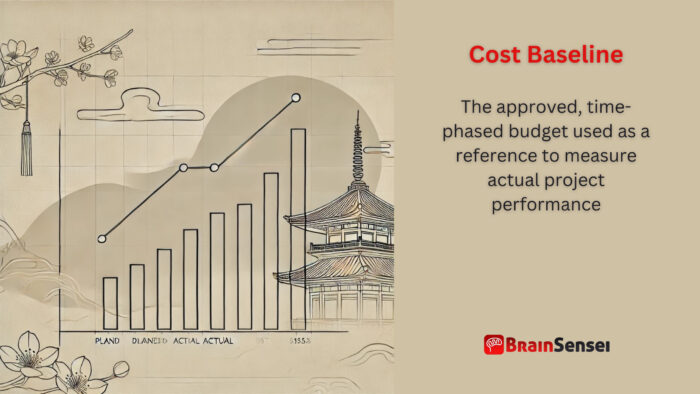
Cost Baseline
What is the Cost Baseline?
A cost baseline is the approved, time-phased budget used as a reference to measure actual project performance. It represents the expected work cost scheduled over a specific period and is a fundamental component of project cost management. The cost baseline helps project managers track financial progress, forecast potential overruns, and maintain budgetary control throughout the project lifecycle.
Key Takeaways
- Establishes the project budget by defining the planned cost over time
- Used for performance measurement through Earned Value Management (EVM)
- Updated only through formal change control processes
- Helps identify cost variances and control financial risks
- Ensures alignment between project scope, schedule, and budget
Understanding Cost Baseline
How It Works
The cost baseline is developed by aggregating the estimated costs of all project activities, including labour, materials, equipment, and overhead. This planned expenditure is distributed across the project timeline to create a time-phased budget.
Project managers compare the cost baseline with actual expenses to determine variances and assess project health. They may initiate corrective actions or change control processes to realign expenditures with the approved budget if deviations occur.
Notes
- The cost baseline is part of the Performance Measurement Baseline (PMB), which includes scope and schedule baselines.
- Variance analysis is crucial for detecting cost overruns early.
- External factors such as inflation, currency fluctuations, and unexpected market changes can affect the accuracy of the cost baseline.
- Adjustments to the cost baseline require formal approval through a change control board (CCB).
- Regular cost monitoring helps maintain financial discipline and accountability.
Related Terms
- Budget at Completion (BAC): The total approved budget for the project
- Earned Value (EV): The value of completed work expressed in terms of the cost baseline
- Cost Variance (CV): The difference between Earned Value (EV) and Actual Cost (AC)
- Planned Value (PV): The authorized budgeted amount for work scheduled to be completed at a given time
- Change Control Process: A formal procedure for modifying the cost baseline when necessary
- Contingency Reserve: A budget allocation for identified risks that may impact project costs
Examples of Cost Baseline in Different Industries
Construction Industry
A construction firm is managing a commercial building project with an approved budget of $5 million over two years. The cost baseline distributes costs across multiple phases, including planning, foundation work, structure, and finishing. By tracking actual expenditures against the baseline, the project manager identifies a cost overrun in the structural phase due to unforeseen labour shortages. This situation triggers a cost variance analysis and leads to resource reallocation to stay within budget.
Construction cost baselines are critical due to fluctuating material costs and labour availability. Suppose steel prices increase unexpectedly; without contingency reserves and proactive monitoring, a project could face significant financial setbacks. Construction managers employ Earned Value Management (EVM) techniques to mitigate such risks and regularly update financial forecasts.
Another factor in construction projects is scope creep, where the project sponsor requests additional work beyond the original project plan. If the project team do not control these changes through a formal change control process, they can push actual costs beyond the baseline. Regular stakeholder meetings and transparent reporting help ensure project costs remain predictable and within budget constraints.
IT & Software Development
A software company is developing a new mobile application with a budget of $500,000. The project team sets a cost baseline, allocating $200,000 for development, $150,000 for testing, and $150,000 for deployment and support. Halfway through development, actual costs surpass planned values due to additional testing requirements. The project manager initiates a change request to adjust the cost baseline, ensuring continued funding without jeopardizing delivery.
Cost baselines help prevent budget overruns caused by unforeseen technical challenges in IT projects. For example, a new software release might require extra security features due to updated regulatory requirements, increasing testing and development costs. Such changes could lead to financial strain and project delays without a flexible but well-monitored cost baseline.
Furthermore, software development often changes its scope when new features are requested. The project could exceed its budget if the business analysts do not adequately assess these features’ financial impact. Agile project management methodologies and cost-monitoring tools help IT teams adapt while staying within economic constraints.
Government Infrastructure Projects
A government agency is involved in expanding a metro rail system, with a cost baseline of $1.2 billion over five years. The project divided the tasks into land acquisition, station construction, and track installation. Regular cost reviews against the baseline reveal a funding shortfall due to rising material costs. This scenario prompts the agency to reassess procurement strategies and seek additional funding approvals.
Public sector projects are highly dependent on cost baselines due to the need for strict budgetary control and accountability. Infrastructure projects often experience external influences such as political changes, economic downturns, and inflation. For instance, if government funding policies shift, a project might need to adjust its baseline to reflect changes in financial support.
Additionally, infrastructure projects require long-term forecasting. For example, a metro rail expansion may span multiple fiscal years, requiring periodic adjustments for inflation, interest rate fluctuations, and workforce availability. Public agencies can enhance financial accuracy and minimize unexpected budget shortfalls by integrating cost baseline tracking with economic forecasting models.
Large-scale infrastructure projects involve multiple stakeholders, including contractors, suppliers, and regulatory bodies. Project costs can deviate significantly if communication among these stakeholders is unclear or financial agreements are not well-defined. Implementing a structured cost control framework ensures that financial expectations align across all involved parties.
Use Cases of Cost Baseline
United States (Healthcare Facility Expansion)
A hospital in California is expanding its emergency department with a budgeted cost baseline of $75 million. Midway through construction, rising labour costs create a $5 million variance. The project manager implements cost-saving strategies, such as value engineering and renegotiating supplier contracts, to mitigate overruns while maintaining quality standards.
The hospital adopted Building Information Modeling (BIM) to control expenses further, improve project coordination, and reduce waste. Integrating digital planning tools minimizes costly rework and enhances budget accuracy.
Germany (Automotive Manufacturing Plant)
An automotive company in Germany is constructing a new electric vehicle production plant. The project cost baseline is €500 million, phased across design, construction, and equipment installation. When unexpected supply chain disruptions cause delays, cost variance reports guide decision-making on schedule adjustments and supplier negotiations to maintain financial alignment.
The company also implements lean manufacturing principles to optimize production processes and reduce waste, ensuring cost adherence to the baseline.
India (Renewable Energy Development)
A solar farm project in India has a cost baseline of $250 million allocated over three years. However, due to changes in government policies and currency fluctuations, project costs deviate from the baseline. The project team revises cost forecasts and secures contingency reserves to manage financial risks while ensuring project completion.
The project remains financially viable despite external economic pressures by leveraging advanced forecasting models and contingency planning.
Best Practices for Managing Cost Baseline
Managing a cost baseline requires a structured approach to ensure financial control and project success. Below are some best practices for maintaining an accurate and reliable cost baseline.
Develop a Detailed Work Breakdown Structure (WBS)
A Work Breakdown Structure (WBS) helps break the project into smaller, manageable components. By creating a transparent cost structure, project managers can allocate costs accurately and ensure the budget accounts for all project elements. A well-defined WBS enables:
- Better cost estimation.
- Easier identification of cost variances.
- Improved accountability among project teams.
Use Earned Value Management (EVM) for Performance Tracking
Earned Value Management (EVM) is a powerful tool for tracking project costs against the baseline. EVM helps in:
- Comparing planned value (PV), earned value (EV), and actual cost (AC) to assess project progress.
- Identifying cost overruns early and taking corrective action.
- Enhancing decision-making through objective performance data.
Implement Regular Cost Reviews and Forecasting
Periodic cost reviews help project managers assess financial health and predict potential budget deviations. Regular forecasting ensures:
- Early identification of potential budget shortfalls.
- Proactive cost adjustments to prevent overruns.
- Continuous alignment with project objectives.
Secure Executive and Stakeholder Buy-In
Aligning the cost baseline with executive and stakeholder expectations ensures smoother project execution. Gaining buy-in from leadership involves:
- Communicating financial objectives.
- Demonstrating how the cost baseline aligns with business goals.
- Providing periodic financial updates to key stakeholders.
Leverage Financial Management Tools
Modern project management software includes cost-tracking and forecasting features. Utilizing tools like Microsoft Project, Primavera, or SAP ensures:
- Real-time cost tracking.
- Automated variance analysis.
- Improved accuracy in financial reporting.
Maintain a Contingency Reserve
A contingency reserve acts as a financial buffer for unexpected project costs. Effective management of contingency funds includes:
- Allocating a percentage of the budget for risks.
- Tracking reserve usage to prevent depletion.
- Adjusting contingency allocations based on risk assessments.
Formalize Change Control Procedures
Changes to the cost baseline must follow a structured change control process to ensure that:
- The Change Control Board (CCB) reviews and approves budget modifications.
- Project teams adhere to financial governance standards.
- The project team thoroughly evaluates the cost impacts of scope changes.
Conduct Post-Project Financial Analysis
After project completion, analyzing financial performance against the cost baseline provides valuable lessons for future projects. A post-project review should include:
- Analyzing budget variances and identifying root causes.
- Documenting best practices and areas for improvement.
- Refining cost estimation techniques for future projects.
By following these best practices, project managers can maintain financial discipline, improve forecasting accuracy, and ensure successful project delivery within budget constraints.
Cost Baseline: Common Mistakes and Issues
Inaccurate Cost Estimation
One of the most common mistakes in cost baseline management is underestimating project costs. If the initial estimates are too low, the project will likely face budget shortfalls, leading to financial stress and potential project failure. Poor cost estimation can be due to incomplete scope definition, overlooked expenses, or reliance on outdated data.
Lack of Contingency Planning
Projects often encounter unforeseen risks such as market fluctuations, supply chain disruptions, or scope changes. These unexpected expenses can push costs beyond the baseline without a contingency reserve. Best practices suggest allocating 5-10% of the budget for contingencies, depending on project complexity.
Failure to Implement Change Control
When changes occur during a project, whether due to new requirements, errors, or stakeholder requests, they must be appropriately reviewed and approved through a formal change control process, failure to follow these procedures can result in cost overruns and a misaligned budget.
Poor Cost Monitoring and Tracking
Project teams may not detect financial discrepancies without real-time cost tracking until it is too late. Lack of transparency in financial reporting can lead to inefficiencies and prevent timely corrective actions. Project management software with built-in cost tracking can help mitigate this issue.
Scope Creep Leading to Budget Overruns
Scope creep occurs when someone introduces additional tasks, features, or requirements without proper cost evaluation. Projects may significantly exceed the baseline budget if scope changes are not documented and assessed for financial impact.
Misalignment Between Schedule and Cost Baseline
A well-developed cost baseline should align with the project’s schedule. If the project performed cost planning in isolation, it may result in unsynchronized cost peaks and project cash flow. Integrating cost and schedule baselines ensures realistic financial forecasting.
Inadequate Communication with Stakeholders
Failure to engage stakeholders early in budget discussions can lead to unrealistic expectations and financial disputes later. Keeping all relevant parties informed about budget constraints, cost updates, and economic risks enhances project success.
Ignoring Inflation and Market Trends in Cost Baseline
Long-term projects must account for inflation and price fluctuations in materials and labour. Ignoring economic changes can lead to budget shortages and financing issues. Project managers should review economic forecasts and adjust baselines accordingly.
Lack of Post-Project Financial Analysis
Many organizations fail to conduct a thorough financial review after project completion. Analyzing variances between planned and actual costs helps improve future cost estimation accuracy and provides insights for better budget management in subsequent projects.
By addressing these common mistakes, project managers can maintain an accurate cost baseline and ensure financial control throughout the project lifecycle.
Frequently Asked Questions (FAQs)
How is a cost baseline created?
A cost baseline is created by estimating the total project costs, allocating them over a timeline, and obtaining formal approval. It includes all direct and indirect costs necessary for project completion.
Can a cost baseline be changed?
Yes, but only through a formal change control process. The project’s change control board must review and approve any adjustments to maintain budget integrity.
Why is cost baseline important in project management?
The cost baseline provides a financial benchmark for tracking actual expenditures. It helps identify cost variances early, allowing corrective action to prevent budget overruns.
What happens if actual costs exceed the cost baseline?
If actual costs exceed the baseline, the project must conduct a variance analysis to identify the root cause. Then, corrective actions can be implemented, such as cost reallocation, scope adjustments, or additional funding requests.
How does Earned Value Management (EVM) relate to cost baseline?
EVM uses the cost baseline to measure project performance. It compares planned value, earned value, and actual costs to determine cost variances and efficiency trends.
Additional Resources
- Cost Management Plan: 6 Items to Include
- Project Cost Management: Principles, Tools, Techniques, and Best Practices for Project Finance
Preparing for a PMI certification?
- Exam Prep Courses: PMP®, CAPM®, and PMI-ACP®
- Exam Simulators: PMP®, CAPM®, PMI-ACP®, PMI-PBA®, PMI-RMP®, PMI-SP®, PgMP®, and PfMP®
- Professional Development Units (PDUs): 15, 30, and 60 PDU Bundles



